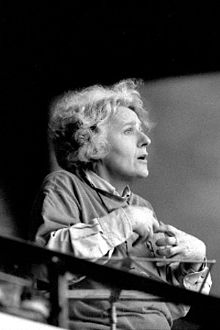
Biography
Ariane Mnouchkine is one of the world’s most pre-eminent female directors. She was born in Boulogne-sur-Seine, France in 1939 and began creating theatre while she was studying at Oxford University in England. She returned to Paris and directed a student theatre group before leaving again to travel extensively and her travels in the East had a particularly strong influence on the development of her work. After her return to Paris in 1964, she and a number of her former colleagues founded the Theatre du Soleil (Theatre of the Sun). The company was established as a workers’ cooperative based on socialist principles and still actively pursues and demonstrates an alternative power structure. While all members respect the autocracy of the director they all agree that collaboration and shared labour is essential. The French government gave the company a home in 1970 in an old munitions factory in the Parisian suburb of Vincennes called the Cartoucherie. Since then, Theatre du Soleil has taken on a cult status in the French popular theatre movement and has also attracted international acclaim. While they still rehearse and perform in Paris, they now tour productions internationally.
Mnouchkine uses a variety of material to investigate themes that explore power structures and their influence on ethical and emotional conflicts. She has produced plays by Shakespeare, the Ancient Greek tragedians Euripides and Aeschylus as well as work by the contemporary French feminist writer and playwright Helene Cixous. All these productions have appropriated and synthesised many Eastern and Western theatre styles and performers are encouraged to adopt any kind of technique that might serve the needs of their character. Performers and performances do not try to replicate or account for the traditions associated with these styles and post-colonial theorists might question the motives behind this kind of cultural appropriation. Nevertheless, with members of over twenty nationalities the company continues to explore and develop a shared store of theatrical images. Major influences include Japanese, Indian theatrical traditions like Kabuki and Kathakali, Chinese theatre traditions, Italian commedia dell’arte and Classical Greek theatre.
Source: https://dlibrary.acu.edu.au/staffhome/siryan/academy/theatres/mnouchkine,%20ariane.htm
Summary
The Subject Matter of Theatre
- History and socio-political issues- “Revolution. War. Apocalypse.”
- Activism towards genocide, violence and immigration/marginalization of social groups
- The rapport between theatre and society
- Counter hyper-commercialisation of theatre
Political Purpose/ Message/ Dramatic Intention
- People’s Theatre
- Raise awareness of past and present socio-political issues
- Incite action and display universal truths
Actor/Audience Relationship
- Joyous, direct, and intimate
- Actors often still preparing when audience enter theatre
- Reaches for a non-elitist audience that should actively listen and interpret
Staging Form
- Large empty playing areas
- Highly physical, use of dance
- Visually stimulating
- De-familiarizing
Directing/ Production Style
- Produce together, collectively and symbiotically
- Director is overseer, not dominant controller
- Strong focus on aesthetic
Design Elements
- Often a highly Asian aesthetic
- Costume, mask, and makeup reflect this
- Over all visual aesthetic is important- speak through images and physicality
- Vibrant and opulent
Role of Actors/ Performance Style
- Actors also part of creation of piece- a collective
- Pushed to be “in the moment” and honest
- Reminiscent of Craig’s idea of marionette or Artaud’s actor-athlete
- Meyerhold’s biomechanics and Lecoq’s physicality- actor as signifier
- Often inspired by Asian performance styles such as Kabuki, Noh, and Kathakali and physicality from Commedia
- Show political identity
- A trained and deep imagination
Technical Elements
- “Kaleidoscopic” use of music, light, and colour (mise en scene)
- Light and shadow
Audience Response
- Should feel emotionally energized by the events on stage
- Resonate and inspire activism and change in the world
- Learning experience
Inspiration
- Asian theatre and Commedia dell’Arte
- Jacques Coupeau
- Physicality if Meyerhold, Lecoq, Artaud, and Craig